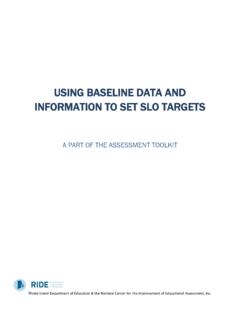Transcription of DISC Self - Assessments 24x7
1 DISC SelfREPORT FOR Sample Report - IC/D STYLE Copyright 2020 All rights reserved. 1 Company Name Here 206-400-6647 SelfAn Evaluation of Behavioral StylesReport For: Sample ReportStyle: IC/DFocus: WorkDate: 10/26/2020 DISC SelfREPORT FOR Sample Report - IC/D STYLE Copyright 2020 All rights reserved. 2 Company Name Here 206-400-6647 of ContentsIntroduction to the DISC styles Online Report ..3 PART I Understanding DISCB ehavioral Styles Overview ..4 Pace and Priority of Each Style ..5A Deeper Look at the Four DISCS tyles ..6 communicating with the II Understanding YourselfGeneral Style Sketch: Adapted Style ..11 Word Sketch: Natural Personalized Behavioral Pattern Tips for Motivations: Wants and Needs.
2 16 What You Bring to the Behavior and Needs Under Stress ..18 Potential Areas for Improvement ..19 The 12 Behavioral Tendencies ..20 Summary of Your Style ..25 PART III Understanding Others and AdaptabilityIntroduction ..26 What is Adaptability? ..27 Recognizing Another Person s Behavioral Style ..28 communicating with Each Style ..29 Tension Among the Styles ..29To Modify Directness and Openness ..30To Modify Pace and Priority ..31 Adapting in Different Situations ..32 Application Activities ..36So Now What? ..39 Why is Independently Tested Accuracy of this Assessment Important?A recent review revealed a significant majority of Assessments available today were absent the studies & reporting to confirm their accuracy. Of the small minority which claimed reporting, the significant majority of those were conducted privately; oftentimes by the assessment provider itself, rather than an objective and scientifically qualified third party. However, we are leading by example in this otherwise unregulated industry.
3 How are we doing this? By submitting our Assessments to an objective, independently conducted battery of tests: Construct Validity, Reliability, and Disparate Impact - all by a qualified scientific authority (Assessment Standards Institute). Our goal? Ensuring the trust and confidence of our users by producing the industry s most accurate and class protected Assessments . Please turn to the last page of this report to learn more on this topic, and the steps we ve taken to safeguard the scientific accuracy of this assessment. DISC SelfREPORT FOR Sample Report - IC/D STYLE Copyright 2020 All rights reserved. 3 Company Name Here 206-400-6647 to the DISC styles Online ReportINTRODUCTIONDISC is a simple, practical, easy to remember and universally applicable model. It focuses on individual patterns of external, observable behaviors and measures the intensity of characteristics using scales of directness and openness for each of the four styles: Dominance, Influence, Steadiness, and Conscientious.
4 Using the DISC model, it is easy to identify and understand our own style, recognize and cognitively adapt to different styles, and develop a process to communicate more effectively with others. HOW TO USE THIS REPORTThe DISC report is divided into 3 parts introducing the DISC model, helping you understand your own style, and identifying ways that you can apply your style strengths or modify your style weaknesses in order to meet the needs of others. Part I focuses on understanding each of the DISC styles and identifying characteristics, including the tendencies of each behavioral style Part II is about understanding yourself and will reveal information about the tendencies that make you unique Part III examines and explores adaptability and offers actionable recommendations for you and others who interact with youWith this personalized and comprehensive report, DISC gives you tools to help you become a better you - to develop and use more of your natural strengths while recognizing, improving upon, and modifying your limitations.
5 Then, because we can easily see and hear these behaviors, we can quickly and accurately read other people and use our knowledge to enhance communication and grow our Note: Any behavioral descriptions mentioned in this report are only tendencies for your style group and may or may not specifically apply to you SelfREPORT FOR Sample Report - IC/D STYLE Copyright 2020 All rights reserved. 4 Company Name Here 206-400-6647 I Understanding DISCBEHAVIORAL STYLESH istorical and contemporary research reveal more than a dozen various models of our behavioral differences, but many share one common thread: the grouping of behavior into four basic DISC styles are Dominance, Influence, Steadiness, and Conscientious. There is no best style. Each style has its unique strengths and opportunities for continuing improvement and DISC styles assessment examines external and easily observable behaviors and measures tendencies using scales of directness and openness that each style DESCRIPTORS OF EACH DOMINANCEINFLUENCESTEADINESSCONSCIENTIOU SD ecisiveCharmingUnderstandingAccurateComp etitiveConfidentFriendlyPreciseDaringCon vincingGood ListenerAnalyticalDirectEnthusiasticPati entCompliantInnovativeInspiringRelaxedCo urteousPersistentOptimisticSincereDiplom aticAdventurousPersuasiveStableDetailedP roblem-SolverSociableSteadyFact-FinderRe sults-OrientedTrustingTeam PlayerObjectiveDIRECTNESS AND OPENNESS OF EACH STYLEPACE AND PRIORITY OF EACH STYLESTYLETENDENCIESDOMINANCET ends to be direct and guardedINFLUENCET ends to be direct and openSTEADINESST ends to be indirect and openCONSCIENTIOUST ends to be indirect and guardedSTYLETENDENCIESDOMINANCEFast-pace d and
6 Task-orientedINFLUENCEFast-paced and people-orientedSTEADINESSSlow-paced and people-orientedCONSCIENTIOUSSlow-paced and task-orientedDISC SelfREPORT FOR Sample Report - IC/D STYLE Copyright 2020 All rights reserved. 5 Company Name Here 206-400-6647 AND PRIORITY OF EACH STYLE PACE AND PRIORITY represent two of the main sources of tension between the styles. D&C and I&S have different PACES: D and I are faster-paced, and S and C are slower-paced. D&I and S&C have different PRIORITIES: D and C are task-oriented, and I and S are people oriented. D&S and I&C have BOTH PACE AND PRIORITY SelfREPORT FOR Sample Report - IC/D STYLE Copyright 2020 All rights reserved. 6 Company Name Here 206-400-6647 DEEPER LOOK AT THE FOUR DISCS tyles Below is a chart to help you understand some of the characteristics of each of the Four Basic DISC Styles, so you can interact with each style more effectively.
7 Although behavioral style is only a partial description of personality, it is quite useful in describing how a person behaves, and is perceived, in personal, social and work to ActAssertivePersuasivePatientContemplati veWhen in Conflict, this StyleDemandsAttacksCompliesAvoidsNeedsCo ntrolApprovalRoutineStandardsPrimary DriveIndependenceInteractionStabilityCor rectnessPreferred TasksChallengingPeople relatedScheduledStructuredComfortable withBeing decisiveSocial friendlinessBeing part of a teamOrder and planningPersonal StrengthProblem-solverEncouragerSupporte rOrganizerStrength OverextendedPreoccupation- goals over peopleSpeaking without thinkingProcrastination in addressing changeOveranalyzing everythingPersonal LimitationToo direct and intenseToo disorganized and nontraditionalToo indecisive and indirectToo detailed and impersonalPersonal WantsControl,VarietyApproval,Less StructureRoutine,HarmonyStandards,LogicP ersonal FearLosingRejectionSudden ChangeBeing WrongBlind SpotsBeing held accountableFollow through on commitmentsEmbracing need for changeStruggle to make decisions without overanalyzingNeeds to Work onEmpathy,PatienceControlling emotions, Follow throughBeing assertive when pressuredWorrying less about everythingMeasuring MaturityGiving up controlObjectively handling rejectionStanding up for self when confrontedNot being defensive when criticizedUnder Stress May BecomeDictatorial, CriticalSarcastic, SuperficialSubmissive, IndecisiveWithdrawn, HeadstrongMeasures Worth byImpact or results, Track recordAcknowledgments, ComplimentsCompatibility, ContributionsPrecision, Accuracy, Quality of resultsDISC SelfREPORT FOR Sample Report - IC/D STYLE Copyright 2020 All rights reserved.
8 7 Company Name Here 206-400-6647 WITH THE DISCS tyles communicating with the DOMINANT StyleD CHARACTERISTICS:SO YOU with being #1 Show them how to win, new opportunitiesThink logicallyDisplay reasoningWant facts and highlightsProvide concise dataStrive for resultsAgree on goal and boundaries, the support or get out of their wayLike personal choicesAllow them to do their thing, within limitsLike changesVary routinePrefer to delegateLook for opportunities to modify their workload focusWant others to notice accomplishmentsCompliment them on what they ve doneNeed to be in chargeLet them take the lead, when appropriate, but give them parametersTendency towards conflictIf necessary, argue with conviction on points of disagreement, backed up with facts; don t argue on a personality basisCommunicating with the INFLUENCING StyleI CHARACTERISTICS:SO YOU with approval and appearancesShow them that you admire and like themSeek enthusiastic people and situationsBehave optimistically and provide upbeat settingThink emotionallySupport their feelings when possibleWant to know the general expectationsAvoid involved details, focus on the big picture Need involvement and people contactInteract and participate with themLike changes and innovationsVary the routine; avoid requiring long-term repetition by themWant others to notice THEMC ompliment them personally and oftenOften need help getting organizedDo it togetherLook for action and stimulationKeep up a fast, lively, paceSurround themselves with optimismSupport their ideas and don t poke holes in their dreams.
9 Show them your positive sideWant feedback that they look good Mention their accomplishments, progress and your other genuine appreciationDISC SelfREPORT FOR Sample Report - IC/D STYLE Copyright 2020 All rights reserved. 8 Company Name Here 206-400-6647 with the STEADY StyleS CHARACTERISTICS:SO YOU with stabilityShow how your idea minimizes riskThink logicallyShow reasoningWant documentation and factsProvide data and proofLike personal involvementDemonstrate your interest in themNeed to know step-by-step sequenceProvide outline and/or one-two-three instructions as you personally walk them through Want others to notice their patient perseveranceCompliment them for their steady follow-throughAvoid risks and changesGive them personal assurancesDislike conflictAct non-aggressively, focus on common interest or needed supportAccommodate othersAllow them to provide service or support for othersLook for calmness and peaceProvide a relaxing, friendly atmosphereEnjoy teamworkProvide them with a cooperative groupWant sincere feedback that they re appreciatedAcknowledge their easygoing manner and helpful efforts, when appropriateCommunicating with the CONSCIENTIOUS StyleC CHARACTERISTICS.
10 SO YOU with aggressive approachesApproach them in an indirect, nonthreatening wayThink logicallyShow your reasoningSeek dataGive data to them in writingNeed to know the processProvide explanations and rationaleUtilize cautionAllow them to think, inquire and check before they make decisionsPrefer to do things themselvesWhen delegating, let them check procedures, and other progress and performance before they make decisionsWant others to notice their accuracyCompliment them on their thoroughness and correctness when appropriateGravitate toward quality controlLet them assess and be involved in the process when possibleAvoid conflictTactfully ask for clarification and assistance you may needNeed to be rightAllow them time to find the best or correct answer, within available limitsLike to contemplateTell them why and howThe first step to building stronger communication is awareness. By identifying how we are similar and different, we can make cognitive choices when interacting to create stronger, more engaged SelfREPORT FOR Sample Report - IC/D STYLE Copyright 2020 All rights reserved.








